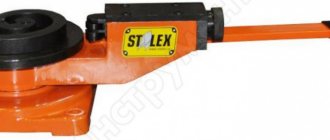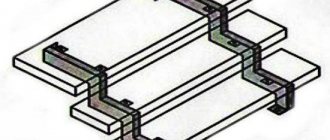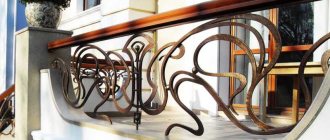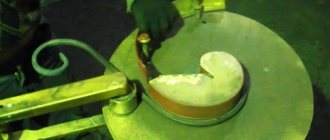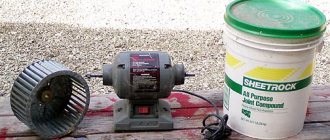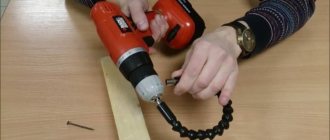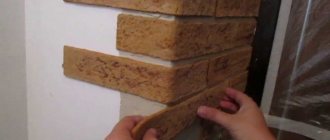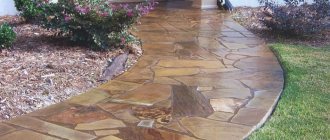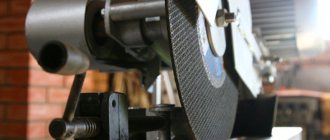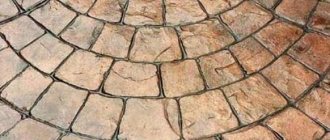Can a forged staircase be made from start to finish with your own hands if you have neither a forge nor the corresponding skills at your disposal? You will be surprised, but the answer will be positive.
A wrought-iron fence that hasn't been touched by a blacksmith's hammer? Is this possible?
Features of forged stair railings
Forged elements look great in any interior. But there are a number of features that must be taken into account when drawing up the project in order to avoid unpleasant surprises after all the work is completed.
The height of the fence and the gaps between the posts must comply with safety standards, especially if there are small children in the house. The recommended height is 1200 mm, and the clearance between the vertical elements of the staircase is no more than 200 mm.
This fence has a number of nuances
The fences are very massive, and the supporting substructure must be designed for additional load. Metal elements of racks are dangerous, and the use of wooden elements of railings and plugs will significantly reduce the likelihood of damage
Stylistic recommendations
A wrought iron staircase can harmoniously “fit” into almost any interior. But before developing a project, you need to take into account the overall design of your home and coordinate the proposed design with it, taking into account the style features.
- Renaissance, Baroque and Empire style items can be combined into one group. A common feature of these styles is floral ornaments intertwined into an intricate pattern of figures and the insertion of monograms. Bronze and copper are preferable as materials for forged elements. A good move would be artificial aging of the metal.
- Ultra-modern styles - techno, hi-tech - require a minimum number of decorative elements and do not welcome smooth ornaments. They require geometric shapes and angular fragments of compositions. Very expressive for these styles is the combination of forging (usually black metal) with polymer and glass elements. Designs with transparent or almost transparent steps look impressive in the interior.
Often there is no typical style in home design - the design combines fragments of different stylistic trends. In this case, you need to select a product either to match the dominant style or to an inconspicuous option so that the design does not stray from the general direction.
* onto metal steps or through the metal base of steps by welding or using bolts.
This question is asked by almost all potential customers during their first conversation. And, as a rule, they do not receive a comprehensive answer, only general information. It's not our fault. To understand the optimal method of installing wrought iron railings, a site visit is required. Here we will try to describe the various installation options in relation to various designs of railings and stairs.
When installing forged railings the following are used:
- support pillars. Pillars (i.e., material that has a sufficient base area for reliable fastening of fences, and can serve as a rigid support) are made of round, square or rectangular pipes; they can also be stacked structures from forged or turned parts, be “smooth” or decorated texture, forging, casting.
- support posts. The cross-section of the posts is the same or not very different from the material of the frame or the design of the forged railings; they are made of solid rolled steel (sq. 16, sq. 20, F 20). They can be straight or curly, and also form part of the concept of the drawing. The racks do not attract attention, create a feeling of lightness, airiness, and are good for short sections of flights of stairs or terraces with turns, radii and corners.
- separate balusters. Separate balusters or blocks require installation into each step and assembly with a frame handrail in place. As a rule, these elements are not optimal in terms of product rigidity, unless we are talking about short sections. The exception is radius stairs and balconies, the shape of which “ties” the structure, spreading the attachment points to different horizons.
Wrought iron railings can be installed:
— On the steps of the stairs (from above).
* by welding onto poles through a heel with a hole for an anchor or pin.
* using a chemical multicomponent composition on “recessed” racks.
* using self-tapping screws and wood grouse (more powerful self-tapping screws with a turnkey head) onto wooden steps through holes in the technical or decorative mounting heel.
* right through the wooden step onto the bolts.
* onto metal steps or through the metal base of steps by welding or using bolts.
When using a technical heel, the decorative element of the fastening unit is a special turned, stamped or cast plate on a pole or rack.
— On the string of the stairs at the end of the ceiling or formwork (on the side).
* on poles or racks with an overlay with 2 or more attachment points. If necessary, welding, pins, wood grouse, chemicals are used. compositions, bolted assembly. The method is possible when installing forged railings on concrete stairs and metal frames. This option allows you to maximize the usable space of stairs, balconies, and terraces.
* here it is implied that at the facility, most of the flights and spans of railings come into walls, partitions or columns. This method is used if the staircase has a closed shaft or the terrace has a colonnade. The set of fasteners and consumables is the same. Pillars and racks are used as necessary, as an intermediate support or support for the beginning (end) of a march.
Installation of forged railings is divided into:
— installation at an intermediate stage
- installation and finishing
In conclusion, a few words about installing forged products on existing pillars of completed objects. You can find on our website wooden, marble, plaster pillars, posts and columns with forged patterns attached. In these cases, our work plays the role of a protective screen in the railings and, of course, an original decoration of the staircase, balcony and the house as a whole.
If you have any questions about installing wrought iron railings, please call or write - we will be happy to answer you. For consultations and on-site measurements, our specialists travel free of charge.
- First of all, polish the finished product well using a grinder;
- Apply a layer of primer to the entire surface of the product. The soil will protect the railings from moisture, thereby saving your stairs from corrosion.
- You can then paint the fence any color you like. The most popular options are black, white and silver.
Materials for forged fences
For forged stair railings, steel grade St3 is usually used. When design features or conditions of further operation require additional properties, the steel grade is changed to one that can meet all the wishes.
If there is a possibility of exposure to aggressive environments, such as high humidity, salt solutions falling on the surface (when located on the seashore or not far from the roadway), austenitic stainless steel is used:
- If it is necessary to increase the safety margin, alloy steels with the addition of metals such as manganese, molybdenum, and tungsten are used.
- For a protective or decorative top layer, bluing or titanium coating, or a polymer or epoxy enamel coating is usually used. The choice of material here will depend on the requirements for decorativeness and operating features.
Important! The choice of material must take into account the operating conditions.
In this video you will learn how to make forged railings:
Selecting material for railings
Cast iron
This design of railings is one of the most reliable, and it looks very “solid”. But using it in a private home is hardly advisable for two reasons. Firstly, significant weight will require the construction of more powerful spans - increasing the cost of work. Secondly, welding cast iron with your own hands is not an easy task. If you choose it, you will have to order injection molded elements and pay a lot of money for them. In fact, you can’t do much on your own.
Stainless steel
Aluminum
Light weight and ease of processing - all this makes this material for railings quite attractive. The only negative is that it cannot be painted, and few people are happy with the constant dim light of a metal fence in a residential building.
The technology of artificially coating such railings with a protective layer (anodizing) at home is difficult to implement. As a rule, lovers of aluminum structures purchase them ready-made, in parts, and assemble them locally with their own hands.
Steel
This option has many opponents, but the author considers it the most acceptable. Firstly, a skilled owner will be able to make railings of any configuration with his own hands. Either using a pipe bender or forging metal. Secondly, the superficial design of the hardware will also not cause much difficulty. There are several methods of chrome plating and nickel plating of metal parts that can be done with your own hands.
An alternative is to use polymer coating technology. So you don’t have to worry about the final appearance of such railings. You can see photos of wrought iron railings here.
It is not necessary to install the railings from one material with your own hands. In private homes, prefabricated structures are no less popular.
Wood
Cheapness and ease of processing are quite significant advantages when making handrails with your own hands. But there are also disadvantages - fragility, the need for systematic maintenance (and this means additional costs), the difficulty of attaching to flight spans made of other materials. If they are wooden, then you can choose such railings. In other cases, this is not the best solution. Perhaps just for the manufacture of some filling elements or handrails.
Plastic
In terms of price, it's a good choice. But besides fragility, there is a more pronounced drawback - susceptibility to mechanical stress. The polymer elements of the railings quickly become covered with scratches, and in most cases they have to be replaced, since only small, insignificant damage can be eliminated.
Copper alloys
It makes no sense to consider it for one reason - the high cost of metal railings. Such designs are not made by hand - only to order.
Rococo is perfectly complemented by asymmetrical and dynamic lines, in which there are almost no right angles. This includes staircase railings for a private house with wide “curls”.
Types of forged railings for stairs
The types of wrought iron fencing are very different and are determined by a number of factors, whether they serve as a fence from casual glances or should transmit light as much as possible. For example, you can make the following classification.
By type of stairs:
- straight, for fencing areas without height differences;
- oblique, for the flights of stairs themselves;
- curved, for spiral staircases.
In relation to a certain interior design style:
- loft is a popular modern style in the spirit of minimalism, characterized by straight lines, without unnecessary details, with basic colors (black, white, gray);
- Empire - imperial style with an emphasis on luxury and an abundance of military-themed elements in the ornament; a combination of black and gold colors is usually used;
- Provence - a light style with airy, simple patterns of thin lines; pastel-colored paint with a patina effect is usually used for coating;
- classic style - inspired by antique designs and classicist architecture, simplicity and grace of lines are combined with decorative elements in the form of flowers, wreaths and crossed arms, a strict combination of black and gold finishes completes the impression.
This is interesting: the features of forged stairs.
The secret of the popularity of forged railings
As a representative of the ancient profession of turning metal into a real work of art, I will reveal the secret of the popularity of forged railings.
When arranging a country house, you should take into account its comfort, style, functionality and safety. The last principle is decisive when choosing enclosing elements. As a result, the railings turn into reliable protection and a true decoration of a suburban area, building and premises.
A variety of forged elements, in which reliability and durability are combined with the imagination and skill of the author, allows you to turn a house into a medieval fortress, a fairy-tale castle, and even an ultra-modern building in the high-tech or minimalist style. No matter what purpose the railings are used for, they are doomed to become part of the exterior or interior. The ability to install functional, stylish and at the same time durable elements explains their great popularity.
With such an awkward design, the manufacture of a metal staircase with your own hands begins.
Manufacturing technology for forged fences
Blacksmithing appeared long before our era, but they learned to use forged elements as stair railings relatively recently. The first known and famous example of the interior use of blacksmithing is Qween House in Greenwich. Built in the first half of the 17th century, the mansion became famous for the tulips woven into the staircase railings. These iron flowers gave rise to a huge chain of imitations, which were often much more successful than the original.
Hot forging technology
Hot forging was known to the ancient Greeks and Phoenicians. For this process, it is necessary to heat the metal until it reaches high ductility, after which it is quite easy to give exactly the shape that is needed. If for copper the processing temperature is about 800 degrees Celsius, for steel it is 1200 degrees. To achieve this range, a regular fire flame will not help, and you will need a blacksmith's forge. Air is supplied into it under pressure, and due to the high combustion intensity, very high temperatures are achieved.
The heated metal is processed using tools that have proven themselves over the centuries:
- anvil;
- hammers of different shapes and weights, depending on the purpose;
- tongs for holding workpieces.
There are several forging technologies.
An experienced blacksmith, with precise blows, quickly turns a steel blank into a sheet of wood or a heraldic shield.
Then all the elements are welded together, forming a single pattern, and acquiring the necessary rigidity. Already the assembled structure is subjected to grinding and anti-corrosion treatment, first with a metal primer, and then with decorative enamel. In modern technology, there are a huge number of ways to coat metal, it all depends on the budget and requirements:
- powder coating, it is applied under the influence of high temperature and electrostatic field;
- hot-dip galvanizing, in a galvanic bath the entire structure is coated with a thin layer of zinc;
- airless spraying, enamel is supplied through a special device;
- Traditional painting using rollers and brushes, with the correct selection of materials, will give a coating that is not inferior in strength to industrial designs.
Cold forging
For cold forging, the metal does not need to be heated, but you will need a large number of special tools. Each technological operation for processing rolled products (bending, thickening, stretching, twisting) will require a separate tool. The necessary templates must also be prepared. As a result, the master’s flight of imagination is greatly narrowed, but there is no need for a forge and high energy costs for heating it.
One type of cold artistic forging is, for example, embossing. The metal workpiece is given the required shape by tapping with a hammer and a special chisel. This process is extremely painstaking and long, but upon completion the metal acquires improved reliability qualities and an unusual texture.
After preparing all the elements, assembly, welding and processing of the structure occur in the same way as during hot forging.
Types of forging
With the help of artistic forging, stair railings are thin and elegant. Such metal structures include an initial pillar and a main part . Forged elements can be made in two ways:
It is possible to increase the degree of decorativeness of metal products with the help of bluing, patination or gilding. For modern trends, parts of the future fencing are painted with special compounds. These measures are necessary not only to increase the decorativeness of the products, but also to protect the material from corrosion.
Separately, we note that forged elements are perfectly combined with a variety of materials: wood, glass, artificial or natural stone. This makes it possible to create truly exclusive designs.
Installation of forged fences
The installation of fencing must be designed at the pre-production stage. On load-bearing elements, it is recommended to prepare a flange for anchoring or a spindle for welding. Anchoring seems to be preferable, as it is easier to install and allows for quick dismantling if necessary. When welding fastenings, you should be especially careful about possible changes in the geometry of the structure due to overheating.
The type of anchors will depend on the material of the steps. For metal, concrete or wood, fasteners are selected in accordance with the calculated load.
Important! Manufacturing must begin with a design in which everything is taken into account, including fasteners.
Installing railings on the porch
Basically, wrought iron railings are mounted on concrete and metal porches. On a concrete porch, the railing is placed on a tile facing in which a hole is made. The cladding can be made of porcelain stoneware or ceramic tiles.
Next follow the instructions:
- To reliably strengthen the railing, you can drive ribbed reinforcement with a diameter of 10-12 mm into a hole of the same size.
- You can also secure the railings by installing them in a liquid concrete solution.
- The fastening can also be done using an expansion anchor. When the nut is tightened, the anchor becomes wedged in the lower area of the hole, preventing concrete from splitting.
- To add a little chic, you can treat the railings with a forging patina. After this, some elements will become decorative.
The installation process is presented in more detail in the video:
Advantages of forged stair railing elements
Forged fences are quite expensive compared to analogues, however, they have undeniable advantages that justify the high price:
- Individuality: Patterned forged steel will definitely make a building stand out and give it a completely unique look. There is no doubt that the building will attract the attention of guests. And if we talk about the financial side, then when selling, the price for unique structures is always higher than for a standard solution.
- Practicality: steel with an additional coating can withstand the most intensive use without maintenance and without losing its appearance and properties.
- Durability: unlike wooden or plastic, forged construction has an almost unlimited supply of strength. The fences will have to be changed only in connection with the reconstruction of the building.
These fences have a number of advantages
Advantages of forged railings: photos of finished projects
Forged elements have been used as design decoration for centuries. They stand out against the background of other interior elements, as they are original and very beautiful. Staircases decorated with metal ornaments are very popular. Such designs are most often used in the interiors of private houses and country cottages.
Forged metal railings attract all attention
Fences of this type have many advantages, which you need to familiarize yourself with in more detail. Forged staircase railings are aesthetically pleasing, which is, of course, their main advantage. They have high strength, so it is almost impossible to damage them mechanically.
Elements made of metal have a long service life. They are resistant to temperature fluctuations. If desired, you can choose one of the standard patterns or place an individual order with an original design.
Separately, it is worth noting the compatibility with various forging materials. Patterns can be simple, linear, or more complex and rich. Caring for such railings is quite simple. Periodically, such a structure must be wiped with a dry cloth. This is quite enough to maintain her presentable appearance.
Metal railings will last for many years without losing their appearance
The main disadvantage of forged products is that they can be susceptible to corrosion. However, this problem only occurs if the structure has not been properly processed. Most often, metal railings are painted, which helps protect them from rusting. This procedure is especially important if the structure is installed outside the house. For example, such fences are often placed on balconies. Wrought iron railings require periodic treatment with special products.
Note! Metal ornaments transform any, even the simplest, interior. Handrails with forged elements can decorate an ordinary staircase made of wood, making it more sophisticated.
Metal structures are used not only in classical style - they can be installed in modern premises. Thus, such fencing is an excellent solution to decorate any interior, regardless of its features.
Forged metal stairs combine well with other materials
Self-production of forged fences
Many people wonder whether it is possible to make a forged fence on their own without contacting specialized companies? Of course, it is possible, all tools and equipment are easily accessible, if we are talking about cold technology, the workshop can be located in a very ordinary room. If you need to equip a hot forging shop, serious fire safety measures will be required. But there are two aspects that nullify all possible savings:
- it will take an order of magnitude more time to master the technology and practice the techniques than when turning to the services of professionals;
- funds for workshop equipment, purchase of tools and consumables will increase the estimate several times.
So, as always, it would be wiser to leave the production of forged railings for stairs in the hands of specialists, of course, if there is no desire to radically change your occupation.
How much will it cost to make metal stairs yourself?
Actually, it's not that expensive. Let's do the math based on the length of the staircase being 2.5 m.
Calculation of parameters of a metal staircase.
In total, if you decide to weld the stairs yourself, the price of such work will be approximately 27,000 rubles. Cheap? In general, yes. However, keep in mind that most companies selling rolled metal work only with wholesale buyers; Finding a company where the materials you need can be purchased in small quantities will be quite difficult, and as a result, the price of the ladder will increase by one and a half, or even double.
Let's summarize all of the above. So, now you know how to make a metal staircase with your own hands, and if you already have experience and all the necessary tools for working with metal, it’s really simple and significantly cheaper than buying a ready-made structure. Otherwise, a better decision would be to buy a ready-made metal staircase - and, by the way, not necessarily an ordinary marching staircase: beautiful and original screw designs are not much more expensive!
Design options for wrought iron railings for stairs in a private house
Before the construction is manufactured, the design is prepared. The sketch can be performed according to two principles. The first option takes into account the presence of rhythmic repetitions. This design is typical for fencing made in a classic style. In this case, all the constituent elements of the structure are repeated in a strictly defined sequence.
Wrought iron railings are great for stairs in country houses
Wrought iron railings for stairs inside a home with rhythmic repetitions are often equipped with column-like posts called balusters. They may be shaped like peaks. Often such structures are equipped with posts made of square rods that twist around their own axis. Elements of artistic forging are also present in this case. Floral motifs prevail in such railings.
The second version of the sketch of forged railings assumes the presence of fantasy patterns. Most Art Nouveau fences are made according to this principle. They are characterized by a large number of bends. Such fencing is most often made without the use of special equipment, so their cost is quite high.
How to choose forged railings: prices for designs
The cost of railings depends on various factors, but the main one is their configuration. For example, the simplest porch fencing, which consists of vertical and horizontal rods, can be purchased for only 1.5 thousand rubles. per linear m. You can also find relatively inexpensive options that include curved fantasy designs. The minimum price for such fencing is 2.5 thousand rubles.
The cost of wrought iron railings for stairs depends on many factors.
When choosing a metal fence, it is recommended to determine the total cost of the project in advance. The price of wrought iron railings for stairs installed inside the house is usually higher than the cost of outdoor counterparts. It can vary from 3 to 20 thousand rubles. per linear m.
Products made to order are more expensive than regular ones. Thus, everyone will be able to choose the necessary design taking into account their specific budget. The most acceptable options are located in the price range from 5 to 10 thousand rubles. per linear m. The most expensive fences are made according to individual drawings.
Spiral staircases with wrought iron railings are quite expensive. The price for such structures can reach 200 thousand rubles. for the complete project. Installation is most often included in a separate price point.
